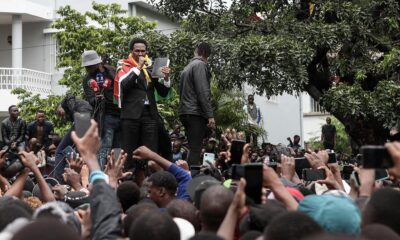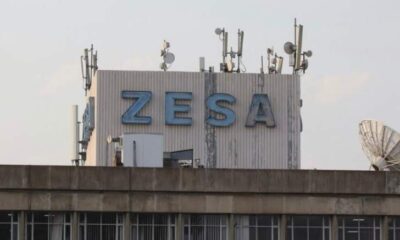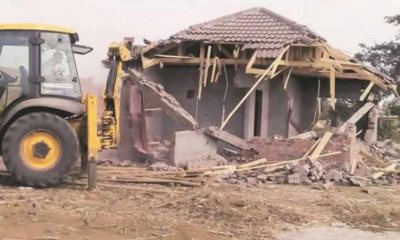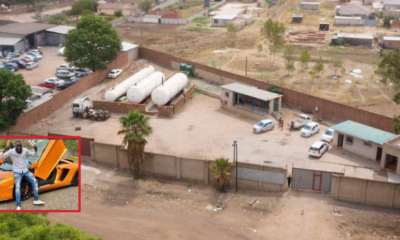
Opinion
Revisited: Parliament warns that Zimbabwe’s mineral leakages are ruinous
Published
2 years agoon
By
NewsHawksThe following abridged report was released in September 2022 by the Parliamentary Portfolio Committee on Defence, Home Affairs and Security. It focuses on the Security of Minerals: Illicit Trading In Minerals and Mineral Leakages.
The NewsHawks is publishing this report in the national interest and in the backdrop of the continued looting and smugging of minerals.
Introduction
Zimbabwe is endowed with over 40 different types of minerals and the mining sector has become the anchor of the economy. According to the National Development Strategy One (2021 to 2025), the mining sector accounts for 60% of the country’s export revenues.
However, the mining industry has been experiencing mineral leakages thereby negatively affecting the sector’s potential contribution to the socio-economic transformation of the country. In 2021, there was an attempt to smuggle gold through the Robert Gabriel Mugabe International Airport (RGM).
In the same year, a Zimbabwean gold smuggler was apprehended at O.R. Tambo International Airport in South Africa. Such acts of mischief potentially create disquiet and discontentment amongst the citizens of this country.
Indeed, illicit trading in the extractive industry, is crippling the country’s economy, creating anarchy in communities and has the potential of bringing untold suffering to ordinary citizens and may threaten national security. It is against this background that the Committee undertook an inquiry into the security of minerals in order to establish the possible causes of mineral leakages in the country and recommend ways of curbing them.
Objectives of the fact-finding visits:
assess the current state of security infrastructure and equipment as well as security systems at ports of entry and established mining companies;
identify challenges faced by law enforcement agencies and players in the mining industry in curbing leakages;
establish causes of mineral leakages and recommend possible ways of mitigating them.
Committee findings
Mineral leakages
There was an acknowledgement by most of the stakeholders that interacted with the Committee that there are leakages of minerals, both precious and base minerals. The quantum could not be ascertained but estimates indicate that this runs into millions of American dollars.
The leakages were prevalent across all minerals, with the gold sector at the top, because there are many players involved that include artisanal and small-scale miners, millers, gold buyers and large-scale producers. At the same time, gold can easily be extracted from the ground using rudimentary methods.
Gold leakages
The Government of Zimbabwe set a target of US$4 billion worth of revenue to be generated by the gold sector by 2023. Whilst the country remains focused onachieving its goal, a lot of gold is allegedly being smuggled out of the country due to a number of factors which include but not limited to the following:
Delays in payment to gold producers
The Committee was informed by small-scale producers that Fidelity Gold Refiners, the sole buyer of gold, takes more than one week to pay producers after surrendering of gold. This is not amenable to the economic well-being of the small-scale producers, because they require their money in the shortest possible period.
As a result, the small-scale producers were selling their gold to unregistered buyers who offer cash upon delivery of the gold. Gold smugglers prefer to sell gold in external markets where they are guaranteed cash payments and not bank transfers. Therefore, buyers would then smuggle the gold out of the country using undesignated exit points and thus robbing the country of thousands of dollars.
Porous land borders
When the Committee visited Beitbridge Border post, it was informed by Zimra officials that there was a stretch of 230 kilometres of the borderline encompassing Zimbabwe, Mozambique and South Africa, which was poorly manned by law enforcement agencies in Zimbabwe. Along that borderline there were over fifteen well-known unregistered exit and entry points between the three countries.
Smuggling was rife at these points and was a source of gold leakages among other commodities. The law enforcement agencies, which include the ZRP and Zimbabwe National Army (ZNA), were unable to control these illegal crossing points because they do not have vehicles and the roads are impassible.
In addition, there was no network coverage in these border lying areas, which made it difficult for law enforcement authorities to coordinate their efforts effectively along the border. The security forces requested for vehicles, tents, drones, testing and communication devices and the establishment of a reaction team to arrest would-be smugglers.
Inadequate equipment and personnel
At the official ports of entry, the Committee was informed by border officials that they did not have modern scanners to detect gold, diamonds and other minerals that may be smuggled out of the country. Officials at ports of entry have limited knowledge of the characteristics of minerals such as gold and diamonds.
ZIMRA outlined that it was in the process of recruiting a metallurgist and a geologist, so that they could be stationed at the land borders to assist in the identification and verification of minerals being exported or those confiscated for attempted smuggling.
At RGM International Airport, two attempts were made to smuggle gold out of the country. In the first case, the gold was intercepted before leaving the country and in the second case the gold was recovered at O. R. Tambo International Airport in South Africa. The major cause of the leakage was due to collusion by airport officials.
Following the two incidents, the Committee was informed that security measures had been tightened to reduce attempts of smuggling. These included the purchase of modern scanners and instituting stringent access measures by airport officials to various parts of the airport. In the absence of insider threat (collusion), the security system at the airport was robust.
Illegal milling and mining operations
The Committee noted with concern that another source of gold leakages was at mining companies that have ownership wrangles. A case in point was Redwing Mine in Penhalonga which experienced an influx of illegal miners following a prolonged ownership wrangle. The Committee had an opportunity to meet former workers, management of Redwing Mine and Better Brands.
The former workers highlighted that a lot of gold leakages were happening through artisanal mining at the tributary granted to Better Brands. The Committee was told by the workers that there were over eight hundred pits and four hundred hammer mills operating in Penhalonga. In addition, there were many gold buyers, both registered and unregistered, operating in the area. Furthermore, there were over thirteen illegal crossing points into Mozambique and it was believed that those routes were being used to smuggle gold out of the country.
The Committee was informed by the workers that, the Ministry of Mines and Mining Development, ZRP and Environment Management Agency (Ema) were struggling to handle the illegal mining, milling and trading activities happening in the Penhalonga area. The local police station has no vehicle for patrols and effective enforcement of the law. Fidelity Gold Refiners were not stationed at the mining site to facilitate the buying of gold.
There were high chances of under declaration of gold produced and finally sold through formal channels. Better Brands told the Committee that its operations were above board and had declared 46,67kg to Fidelity Gold Refiners for the eight months it had been in operation since July 2021. They asserted that illegal hammer mills that had mushroomed near its mining tribute posed serious operational challenges and were a source of massive gold leakages.
Besides the loss of revenue through smuggling of gold from Penhalonga, the Committee learnt that there were environmental challenges which have resulted in the loss of both people and livestock.
It was reported by some aggrieved community members that rivers and streams in the vicinity had been contaminated by cyanide which is a very hazardous mining chemical.
Formal gold mining operations
The Committee visited Renco Gold Mine which is under RioZim and was informed that the company has always been able to account for all its gold, from the extraction of the ore up to elution point, where gold was extracted.
In terms securing the precious mineral, the Committee noted that the company had adequate security systems in place which included a perimeter fence, Closed Circuit Television (CCTV) and well equipped security guards. It also emerged that gold production at the mine was on the decline due to a number of factors which included poor ore grade and power outages among others.
However, the security management at the mine appealed to the Committee to assist the company to acquire authorization to use drones to augment existing security systems. Nevertheless, the Committee queried the absence of State security or government officials at the mining site to verify whether production statistics on site were not tempered with.
The Committee could not rule out the possibility of under declaration of gold because there were no government officials at any of the privately owned gold mines in the country to verify or monitor production statistics at the source. It was observed that the Ministry of Mines and Mining Development receives and accepts production statistics sent by gold mining companies in good faith.
Diamond leakages
The Committee toured ZCDC and Anjin Investments in Marange and interacted with management and employees, particularly those in the security sector. The Committee noted that the companies had robust security systems at their diamond concessions.
Security mechanisms put in place included; CCTVs, drones, perimeter fence and armed security guards with a canine unit. It was also established that the security standards were in line with the Kimberly Process Certification Scheme (KPCS) requirements so that no diamonds could be smuggled from Zimbabwe.
However, the presence of artisanal diamond miners in the Marange diamond concessions pointed to the prevalence of incidents of smuggling happening outside the diamond concession owned by the two companies. Representatives of Anjin Investments, ZCDC and ZRP informed the Committee that the major perpetrators of smuggling of diamonds were the mining communities who provided shelter to the illegal miners.
Spokespersons for the local community casually admitted that they offered shelter to illegal miners to cushion themselves against the unbearable economic hardships. Some even openly expressed their disgruntlement over their debilitating socio-economic status and pledged to continue harboring illicit diamond mining and trading activities until the State and all responsible authorities took action to improve their wellbeing through community development and related empowerment programmes.
It was noted by the Committee that all diamonds recovered by unlicensed miners and traders ultimately evaded the formal diamond value chain, possibly finding their way into Mozambique en-route to Europe and the Arab world.
The Community further alleged that there were cases of connivance between private mine guards and either licenced miners or underpaid mine employees leading to diamond leakages. Furthermore, the Committee observed that full exploration of the Marange area had not been done, as a result, the area remained vulnerable to incidents of smuggling of diamonds. MMCZ highlighted that there was a legislative gap to integrate artisanal diamond miners so that all diamonds could be channeled through the formal system.
In addition to the above loopholes, Civil Society Organisations in the Marange Diamond Community cited the following as contributing to diamond leakages:
• Failure by mining companies to relocate villagers living in diamond concessions;
• Failure to fence off all the mined areas to inhibit access by livestock and unlicenced miners;
• Security agents were involved in organising syndicates with unlicensed miners and traders especially in the green zones (Green Zones are low risk areas that occupied by communities and are accessible to all and sundry);
• Acts of collusion between law enforcement agencies and illegal diamond miners and buyers at roadblocks;
• Non-rotation of state security personnel in protected areas and at entry and exit points; Delays in operationalising the Community Diamond Concession and the 5% equity granted to the Community by the Zimbabwe Diamond Policy.
This has created dissatisfaction amongst villagers, hence were not willing to assist in curbing diamond leakages.
• Failure to implement recommendations emanating from several past visits conducted in Marange by Parliamentary Portfolio Committees, such as the Chindori-Chininga report of 2013.
Platinum leakages
The Committee visited Mimosa Mine which is one of the major platinum producers in the country.
Platinum is one of the major sources of foreign currency for the country. The platinum sector is expected to generate US$3 billion worth of revenues by 2023 and it is anticipated that the industry will surpass that target. Platinum companies in Zimbabwe export platinum concentrate to South Africa because the country does not have a Precious Metal Refinery.
There are ten minerals that are extracted from the concentrate that include; platinum, palladium, rhodium, gold and silver among others. The Committee explored the company’s laboratory where assaying of the concentrate was done before it was exported out of the country.
It was observed that all the vehicles used to export the concentrate were on satellite tracking and the company had not experienced any attempts of theft. However, the Committee was concerned about the knowledge gap between company and government officials on the actual quantum and value of minerals in the concentrate before it was exported out of the country.
It was noted that the accounting system, called Meta Accounting, used by the companies is very complex and government does not always have skilled personnel and laboratories to verify the assays done by platinum companies in the country.
Leakages of base minerals
The Committee was informed by the General Manager of MMCZ, Mr. T. Muzenda that a truck with a consignment of 130 tons of chrome was impounded and the suspects attempted to smuggle the mineral using fake export documents purportedly issued by MMCZ.
Chrome is one of the major minerals on global demand and is being mined in various parts of the country by both large scale and small-scale producers. MMCZ indicated that leakage of base minerals was being exacerbated by the fact that the National Railways of Zimbabwe (NRZ) was not fully operational.
Road transportation has a higher risk of smuggling of base minerals, Companies can under declare the weight of some of their cargo because the country does not have a lot of weighbridges.
Furthermore, it was easy for chrome producers to smuggle the mineral out of the country through unofficial routes.
Leakages of semi-precious stones
MMCZ informed the Committee that there was high prevalence of smuggling of semi-precious stones in the country due to the fact that the producers are failing to secure markets close to their operations. These semi-precious stones are being smuggled to countries such as Zambia. At the same time there was no legislation to regulate the production of semi-precious stones in the country.
Aerodromes scattered in the country
The Committee was informed by the Airports Authority of Zimbabwe that Government’s presence at aerodromes is restricted to eight commercial airports. At some private aerodromes located in different parts of the country, there is minimal direct involvement. This was an area of concern for the Committee as it can be a source of mineral leakages.
Law enforcement agencies
It was highlighted that law enforcement agencies play a critical role in securing minerals. It is their duty to enforce the law without fear or favour. Their presence at ports of entry, along the borderline, in and around mining communities and along major roads serves as a deterrent against illegal traders of precious stones such as gold and diamonds.
In as much as their role is appreciated, it was reported by mining communities that some deployed law enforcers collude with illegal gold and diamond miners and traders at mining sites, at designated and undesignated entry and exit points. People in Chiadzwa openly stated that state security had the habit of allowing illegal diamond miners and buyers passage into diamonds zones in exchange for kickbacks. At some gold sites, it was reported that members of the State security had their own pits mined on their behalf by illegal miners and the gold produced would never find its way to Fidelity Printers and Refiners.
Inadequate tools of trade, lack of all-terrain patrol vehicles, poor remuneration and public intolerance of state security among others have been cited as some of the most common challenges faced by law enforcement agencies during the course of their duty. These challenges hamper effectiveness in the fight against smuggling of minerals.
Committee observations
i. It is difficult to penetrate the security systems at Robert Gabriel Mugabe International Airport in the absence of insider threats, that is, without the planned involvement of rogue elements among the employees;
ii. There is suspicion of massive under declaration of gold produce at elution plants. The absence of Fidelity Gold Refiners and State security agencies such as the Flora and Fauna Unit of the Zimbabwe Republic Police, compromises the security of minerals at processing or cyanidation points;
iii. Fidelity Gold Refiners lacks visibility and is not always adequately capacitated financially and therefore has limited competitive advantage over the other players in the gold buying field in terms of the price they offer and reliability on payment. Its absence in places occupied by artisanal miners provides room for illegal dealers to buy gold which is then smuggled out of the country;
iv. The country’s porous borderline remains a major cause for concern. It provides easy pathways for mineral leakages, particularly gold and diamonds, which can easily be smuggled out through undesignated exit points.
v. Unregistered milling plants in areas crowded by artisanal miners are a source of gold leakages. Urgent action by government is required to register all the milling plants;
vi. The absence of a platinum refinery plant in the country remains a major cause for concern and it has the potential of creating leakages considering that processing of platinum (and the other 10 minerals) is done in Rustenburg in South Africa in the absence of security personnel from Zimbabwe. There is a possibility of understating of the actual statistics and value of minerals after processing in foreign environments;
vii. Massive exploitation of minerals, coupled with lack of substantial community development and economic empowerment programmes for local mining communities, is a major source of disgruntlement which quite often degenerates into anarchy;
viii. There is limited or no sense of ownership of minerals by local mining communities due to a sheer feeling of insecurity, hopelessness and lack of meaningful, robust and sustainable corporate social responsibility projects that guarantee continuity after the depletion of the minerals. In the process, the communities would display an ‘I don’t care’ attitude on curbing mineral leakages because they feel that these minerals are not benefiting them directly;
ix. Mineral leakages were being exacerbated by a plethora of factors, chief among them being the absence of a stringent legal framework in the mining industry, delay in regularising and integrating artisanal diamond and gold miners into the mainstream economy, weak enforcement mechanisms and alleged laxity by some members of law enforcement agencies;
x. The country has the capacity to curb mineral leakages, because the chief perpetrators are citizens, starting with those at grassroots level, up to those holding positions of influence in the country;
xi. It is beneficial for Government to move with speed to plug mineral leakages from smuggling through enhancing traceability mechanisms in line with international best practice such as the Organisation for Economic Co- operation and Development (OECD) Guidelines on Due Diligence for Responsible Mineral Supply Chains;
xii. Illegal mining and illicit trade in minerals are a cause for concern which have the potential of being a security threat as has happened in West Africa and in neighbouring Mozambique;
xiii. There is a knowledge gap in the public domain on the significance of securing minerals and cultivation of a true sense of ownership of mineral resources as means of curbing leakages;
xiv. There is an outcry from mining communities, especially in diamond mining areas, about state security engaging in acts of corruption and thereby fueling illegal mining and trading of precious minerals.
Committee recommendations
i. By 31 December 2022, the Ministry of Mines and Mining Development:
• Should review and amend the diamond policy and legislation on mining and trading of gold in order to integrate artisanal diamond and gold miners in the mainstream mining industry;
• together with Minerals Marketing Corporation of Zimbabwe and Fidelity Gold Refiners, should deploy officials at regular intervals to conduct inspections and verifications of the operations of big mining companies of precious minerals to ensure that under declaration of minerals at elution plants is curtailed;
i. Come up with a policy to regulate semi-precious stones produced in the country, in order to curb leakages in that sector;
ii. Beginning 1 January 2023, Fidelity Printers and Refiners should reduce its time lag in the payment of gold deliveries made by small-scale miners so that more gold finds its way into the formal system. Payment on delivery should be prioritised and a bonus or premiums should be paid for higher quantities so as to encourage trading of gold through formal channels;
iii. By 31 October 2023, Minerals Marketing Corporation of Zimbabwe and Fidelity Gold Refiners should assist in providing technical skills training law enforcement agencies and Zimbabwe Revenue Authority personnel at ports of entry on mineral identification and detection in order to enhance their capabilities of identifying minerals on the spot;
iv. By 31 October 2023, all unlicensed hammer mills that are scattered around the country must be registered by the Ministry of Mines and Mining Development and steep fines must be imposed on any illegal operations of unlicenced hammer mills;
v. By 30 June 2023, the Ministry of Mines and Mining Development should review the mining model at Redwing Mine in order to adopt a sustainable mining model that integrates former mine workers and the surrounding community so that leakages are minimised;
vi. In the 2023 budget, the Ministry of Finance and Economic Development should allocate adequate financial resources which must be released on time to the security sector, the ZRP in particular, for the purchase of surveillance equipment, detection devices, all-terrain patrol vehicles and motorbikes, heavy duty weighing scales, computers (laptops), communication devices and other accessories required in manning the country’s ports of entry including the long stretch of the country’s borderline;
vii. By December 2023, Zimbabwe Consolidated Diamond Companies and Anjin Investments should ensure that families currently residing in designated diamond concessions or Special Grant Areas are properly relocated in well-established resettlement sites that can sustain the affected families;
viii. By 2027 the Ministry of Mines and Mining Development, in collaboration with platinum mining companies, should construct a platinum refinery plant to allow for processing of platinum locally as a means of enhancing beneficiation as well as curbing leakages.
ix. The Ministry of Home Affairs and Cultural Heritage and all the other ministries providing security in gold and diamond fields, must ensure that deployment of law enforcement personnel in those sites is strictly on a rotational basis to avoid the same officers overstaying in those areas. This will contribute to curbing alleged collusion and corruption involving state security in gold and diamond fields.
Conclusion
Minerals are a major contributor to the country’s socio-economic development. All forms of illicit activities in the mining, processing and marketing of minerals risk plunging our country into economic, social and political turmoil. When the economy bleeds, political mischief and social unrest become imminent thereby threatening national security.
Indeed, safeguarding minerals is not for law enforcement agencies alone; rather, it is everyone’s responsibility. State institutions, private entities, civil society organisations and the general public have the responsibility to jealously guard the country’s mineral wealth.
A whole-of-society approach on plugging mineral leakages is critical now than ever before in order to promote sustainable development, peace and security. Let us all work together to stop mineral leakages.
You may like




















